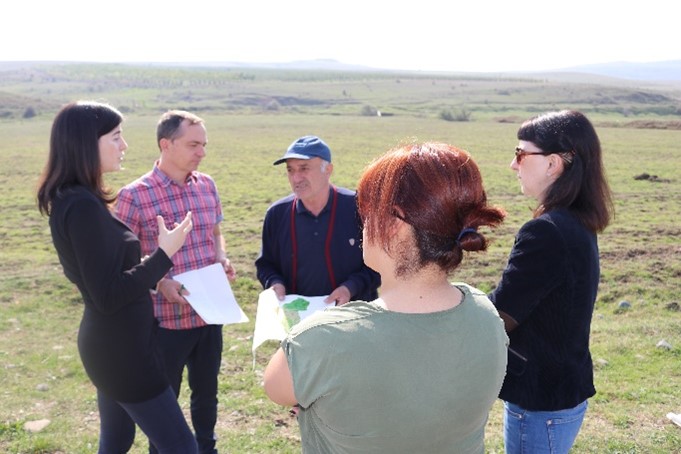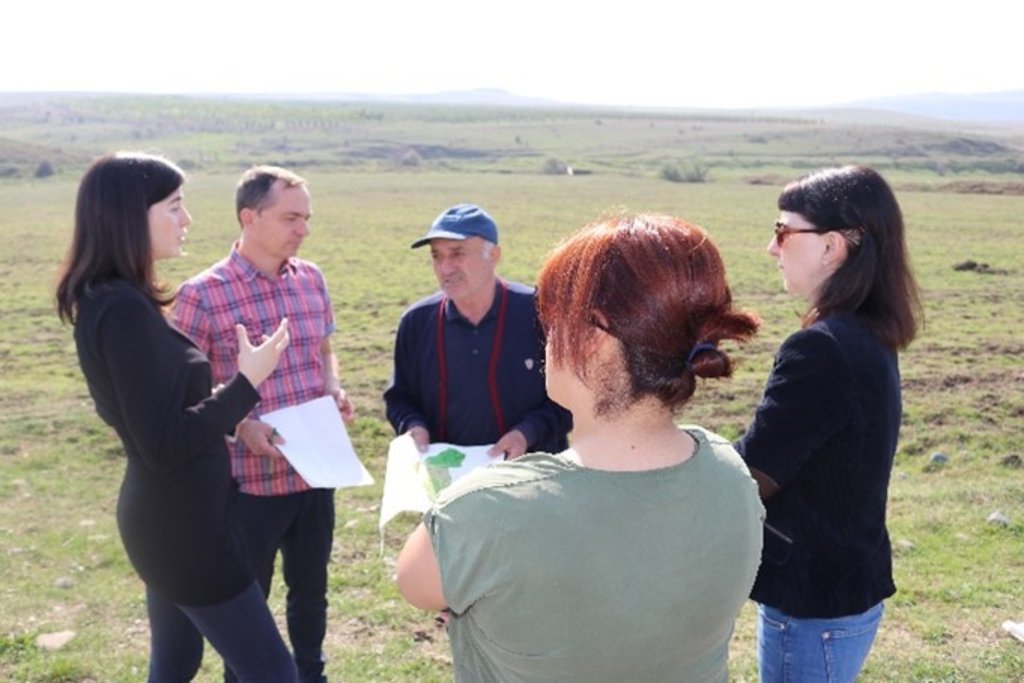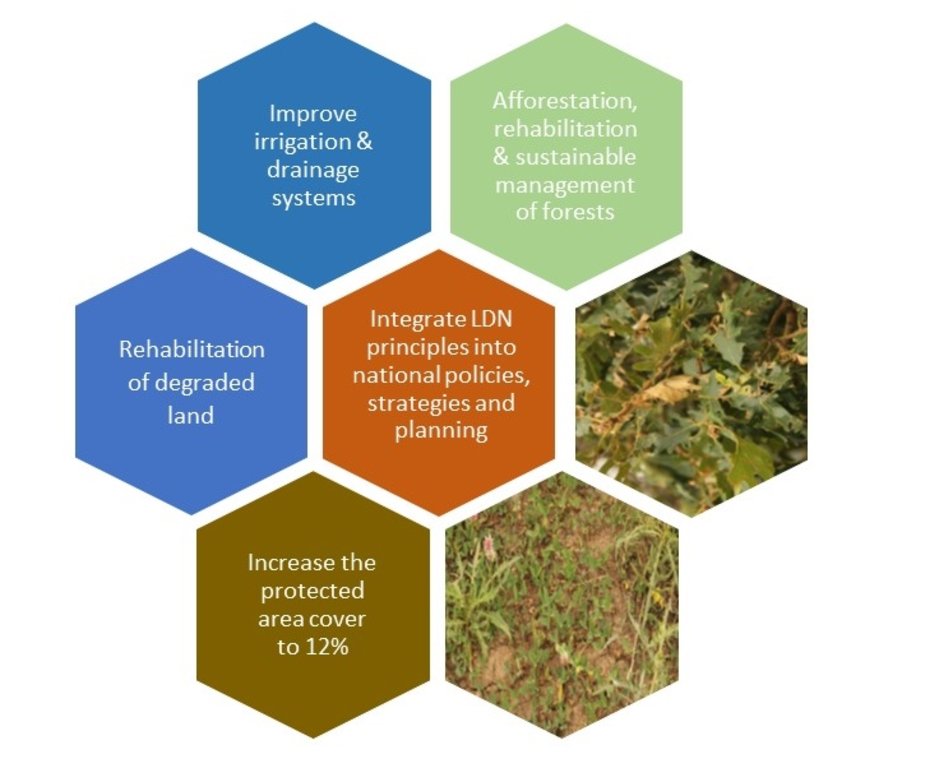Land Degradation Neutrality Transformative Projects and Programmes (LDN-TPP) for sustainable agriculture and rural development [Géorgie]
- Création :
- Mise à jour :
- Compilateur : Daniel Zollner
- Rédacteurs : Anneliese Fuchs, Michael Huber
- Examinateurs : William Critchley, Rima Mekdaschi Studer
LDN-TPP in Georgia
approaches_5902 - Géorgie
Voir les sections
Développer tout Réduire tout1. Informations générales
1.2 Coordonnées des personnes-ressources et des institutions impliquées dans l'évaluation et la documentation de l'Approche
Spécialiste GDT:
Spécialiste GDT:
Zumbulidze Maia
REC Caucasus
Géorgie
Nom du projet qui a facilité la documentation/ l'évaluation de l'Approche (si pertinent)
Generating Economic and Environmental Benefits from Sustainable Land Management for Vulnerable Rural Communities of Georgia (GREENLANDS)Nom du ou des institutions qui ont facilité la documentation/ l'évaluation de l'Approche (si pertinent)
Global Environment Facility Georgia (GEF Georgia) - Géorgie1.3 Conditions relatives à l'utilisation par WOCAT des données documentées
Quand les données ont-elles été compilées (sur le terrain)?
04/11/2019
Le compilateur et la(les) personne(s) ressource(s) acceptent les conditions relatives à l'utilisation par WOCAT des données documentées:
Oui
1.4 Références au(x) questionnaire(s) sur les Technologies de GDT
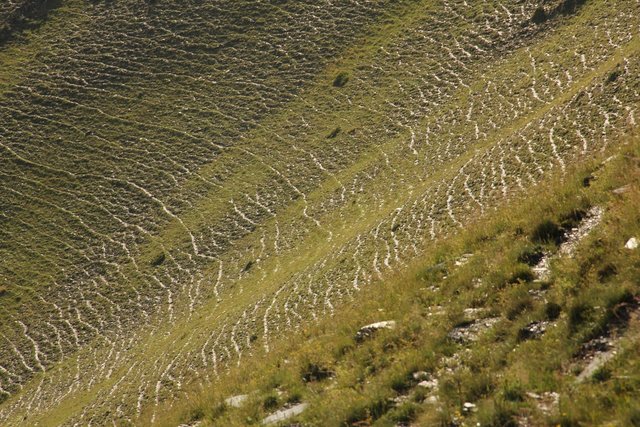
Remote Sensing as a Tool for Land Degradation … [Géorgie]
Land degradation contributes to biodiversity loss and the impoverishment of rural livelihoods in Tusheti. Above all, however, land degradation are triggered by climate change as traditional land use practise might not be adapted to new climate conditions which can cause or speed up degradation processes significantly. On the other hand, …
- Compilateur : Hanns Kirchmeir
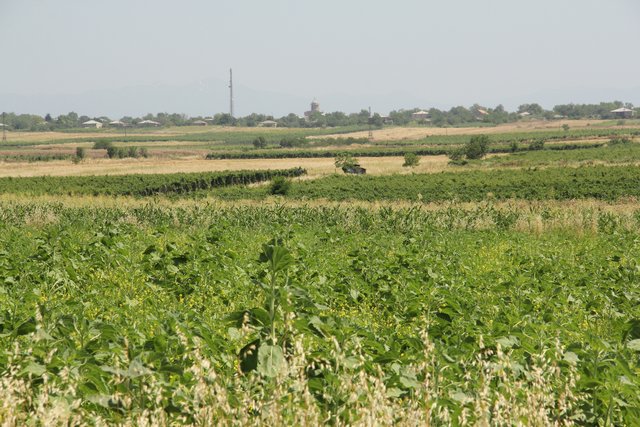
Community Land Use Planning in Arkhiloskalo [Géorgie]
Unsustainable land use practices, such as deforestation, overgrazing and improper agricultural management systems are triggering the loss and degradation of valuable land resources in Georgia. Land use planning is one of the measures among others to contribute to support the integration of good Landscape and Sustainable Land Management (L-SLM) principles …
- Compilateur : Hanns Kirchmeir
2. Description de l'Approche de GDT
2.1 Courte description de l'Approche
In the framework of the project ‘Generating Economic and Environmental Benefits from Sustainable Land Management for Vulnerable Rural Communities of Georgia’, Land Degradation Neutrality Transformative Projects and Programmes (LDN-TPP) were developed to implement the LDN targets at municipal level.
The approach defines the process to break down global and international LDN targets and to translate these into local contributions from the municipalities of Gori, Kareli, Kvareli and Sagarejo.
2.2 Description détaillée de l'Approche
Description détaillée de l'Approche:
The three-year project ‘Generating Economic and Environmental Benefits from Sustainable Land Management for Vulnerable Rural Communities of Georgia' funded by the Global Environment Facility (GEF), is implemented by the United Nations Environment Programme (UNEP) and executed by the Regional Environmental Centre for the Caucasus (RECC). The initiator and beneficiary of the project is the Ministry of Environmental Protection and Agriculture of Georgia. Within this framework, Land Degradation Neutrality Transformative Projects and Programmes (LDN-TPP) were developed to implement the LDN targets at municipal level.
The project aims to create an enabling environment at the community level to achieve the country's goal of Gender Responsive Land Degradation Neutrality (LDN). The project supports local farmers to apply sustainable land management and climate-smart agricultural practices to promote food security and resilience in order to reduce the impacts of erosion, salinisation and soil fertility reduction in Sagarejo, Kvareli, Gori and Kareli on 20,000 ha of pilot land. As a result, it is expected that there will be an improved understanding of the economics of land degradation and integrated land use planning at national and sub-national levels. In the preceding approach recorded under WOCAT, namely ‘Integrated Land Use Plans (ILUPs) for sustainable agriculture and rural development with special emphasis on SLM, CSA and LDN in four municipalities [Georgia]’, ILUPs were developed for four municipalities providing a detailed spatial basis. A separate study (Ballesteros et al. 2020) compiled baseline information about LDN indicators.
This approach complements the ILUP. It combines the spatial information elaborated for land use planning, the LDN baseline information with national LDN targets, UNCCD principles for LDN and municipal stakeholder priorities to come up with a concrete plan for the municipal contribution to (inter)national targets. Thus, this approach serves to operationalise the national LDN targets at municipal level. At the time of documentation of this apporach, planning was completed and the participatory process for validation and decision-making for concrete targets had been initiated.
Taking this into account, a targeted programme was designed, which breaks down national targets into municipal targets with related activities and spatially explicit priority areas for implementation. This approach serves to operationalise LDN-related recommendations and proposed actions as presented and defined in the Integrated Land Use Plan. It seeks to define the contribution of the municipalities Gori, Kareli, Kvareli and Sagarejo to the achievement of national and global LDN targets.
The output is intended to serve as a starting point for local discussion (especially with the LDN Working Group) to further specify and prioritise the objectives and measures proposed. It provides a solid basis for discussing (a) concrete measures and (b) the areas best suited for these measures. The approach is documented in a consolidated document on how the municipality can contribute to the national LDN goals, based on the specific situation and potentials of the municipality.
The LDN TPP focuses on specific objectives and actions in the area of the municipality and its various functional land units in a pro-active, forward-looking and visionary manner as a contribution to the nationally set LDN objectives and the overall LDN vision. It presents possible and recommended development pathways and focuses predominantly on LDN implementation options through the application and adoption of various SLM and CSA practices.
2.3 Photos de l'approche
2.5 Pays/ région/ lieux où l'Approche a été appliquée
Pays:
Géorgie
Région/ Etat/ Province:
Shida Kartlii and Kakheti
Autres spécifications du lieu :
Gori, Kareli, Kvareli and Sagarejo
Commentaires:
The points are located within the four municipalities of Gori, Kareli, Kvareli and Sagarejo. The land use plan was prepared for the entire territory of the four municipalities.
Map
×2.6 Dates de début et de fin de l'Approche
Indiquez l'année de démarrage:
2019
2.7 Type d'Approche
- fondé sur un projet/ programme
2.8 Principaux objectifs de l'Approche
The approach seeks to define the local contribution of the municipalities Gori, Kareli, Kvareli and Sagarejo to the achievement of national and global LDN targets whilst meeting local needs and priorities
2.9 Conditions favorisant ou entravant la mise en œuvre de la(des) Technologie(s) appliquée(s) sous l'Approche
normes et valeurs sociales/ culturelles/ religieuses
- favorise
There is a recognised need to improve land use planning and to counter land degradation as agricultural production is declining
disponibilité/ accès aux ressources et services financiers
- entrave
Even though funding is provided through the project, the resources available at the municipality are very limited.
cadre institutionnel
- favorise
The establishment of Municipal LDN Working groups allows for a concrete discussion of LDN with adequate municipal participation. It also allows for including local knowledge in the planning process
- entrave
Currently, municipalities have very limited capacities for land use planning.
collaboration/ coordination des acteurs
- favorise
REC has a very strong presence and links to the municipalities through previous and ongoing projects.
- entrave
This was very challenging due to COVID-19 restrictions. Fewer meetings were held than foreseen delaying the process of discussion of municipal targets and activities.
cadre juridique (régime foncier, droits d'utilisation des terres et de l'eau)
- entrave
For the strategic planning, land tenure was only a minor topic. However, in general, when it comes to the specific location of measures, land tenure will be amongst the key issues.
cadre politique
- favorise
Well-supported through municipal involvement.
gouvernance foncière (prise de décisions, mise en œuvre et application des décisions)
- favorise
Municipal LDN group as municipal sounding board was a big plus.
connaissances sur la GDT, accès aux supports techniques
- favorise
There are several successful previous projects already providing a good set of measures and creating awareness amongst land users for SLM
3. Participation et rôles des parties prenantes impliquées dans l'Approche
3.1 Parties prenantes impliquées dans l'Approche et rôles
- exploitants locaux des terres / communautés locales
Various farmers
Visits to the fields with the local farmers, discussions about the type of cultivation
- chercheurs
Tbilisi State University
Contribution of expert knowledge during meetings to interpret findings in a municipal context; provision of relevant scientific data;
- ONG
REC Caucasus
Supervisors, consultants, GIS analyses, participation in the LDN Working Group Meeting
- gouvernement local
Executive Office of the Gori Municipal Council
I Mayor’s City Hall (formerly Municipal Administration“Gamgeoba”), Municipality of Gori
I Mayor’s City Hall (formerly Municipal Administration“Gamgeoba”), Municipality of Kareli
I Mayor’s City Hall (formerly Municipal Administration“Gamgeoba”), Municipality of Kvareli
I Mayor’s City Hall (formerly Municipal Administration“Gamgeoba”), Municipality of Sagarejo
Participation in the LDN Working Group Meeting
- gouvernement national (planificateurs, décideurs)
Agricultural and Rural Development Agency (ARDA)
Ministry of Environmental Protection and Agriculture of Georgia (MEPA)
Participation in the LDN Working Group Meeting
3.2 Participation des exploitants locaux des terres/ communautés locales aux différentes phases de l'Approche
| Participation des exploitants locaux des terres/ communautés locales | Spécifiez qui était impliqué et décrivez les activités | |
|---|---|---|
| initiation/ motivation | aucun | |
| planification | passive | Local land users were consulted to gain experience and insight into the situation of agriculture in the different areas. The interviews were then incorporated in the preparation of the maps and land use plans. Stakeholder priorities formulated during the meetings were the basis for the setting of the municipal targets. Due to COVID 19 the related participatory process to validate the proposed targets, activities and locations has only started recently. Thus, finally the classification would rather refer to "interactive planning". |
| mise en œuvre | aucun | |
| suivi/ évaluation | aucun | M&E will be provided in a later stage once the decisions are made regarding the final activities and priorities |
3.4 Prises de décision pour la sélection de la Technologie/ des Technologies
Indiquez qui a décidé de la sélection de la Technologie/ des Technologies à mettre en œuvre:
- principalement les spécialistes de la GDT, après consultation des exploitants des terres
Expliquez:
After initial consultations, the plan was prepared based on scientific and GIS-based information translating it into a muncipal programme. The process will be concluded once the programme is validated and discussed with land users and municipal administration (ongoing process).
Spécifiez sur quelle base ont été prises les décisions:
- l'évaluation de connaissances bien documentées en matière de GDT (prises de décision fondées sur des preuves tangibles)?
- les résultats de recherches?
- expériences et opinions personnelles (non documentées)
4. Soutien technique, renforcement des capacités et gestion des connaissances
4.1 Renforcement des capacités/ formation
Une formation a-t-elle été dispensée aux exploitants des terres/ autres parties prenantes?
Non
4.2 Service de conseils
Les exploitants des terres ont-ils accès à un service de conseils?
Non
4.3 Renforcement des institutions (développement organisationnel)
Des institutions ont elles été mises en place ou renforcées par le biais de l'Approche?
- oui, un peu
Spécifiez à quel(s) niveau(x), ces institutions ont été renforcées ou mises en place:
- local
Décrivez l'institution, ses rôles et responsabilités, ses membres, etc.
Within the framework of the project, municipal Land Degradation Neutrality Groups were established comprising municipal stakeholders and land users. This board serves to discuss LDN issues, define priorities and provide knowledge about local phenomena of land degradation (e.g. participatory mapping of degradation)
Précisez le type de soutien:
- renforcement des capacités/ formation
Donnez plus de détails:
Basically, these groups were consulted for the identification of priorities and land-degradation mapping in the municipality. In a follow-up step, these groups will play a crucial role in decision-making and implementation of the programme.
4.4 Suivi et évaluation
Le suivi et l'évaluation font ils partie de l'Approche? :
Non
Commentaires:
The current approach designed a LDN-TPP at municipal level. Once the municipality decides about the final priorities and measures to be taken, a monitoring plan will be included.
4.5 Recherche
La recherche a-t-elle fait partie intégrante de l’Approche?
Oui
Spécifiez les thèmes:
- sociologie
- écologie
- technologie
Donnez plus de détails et indiquez qui a mené ces recherches:
The designed programme builds on 3 main elements: (1) local knowledge through project-based experiences and implicit knowledge of land users and the LDN group, (2) a spatial analysis of land use within the frame of the land-use planning process (see Zollner, 2021, separate approach recorded under Wocat) and (3) a LDN baseline study about the three global LDN indicators (land cover, net primary production and soil organic carbon) (Ballesteros et al. 2020).
5. Financement et soutien matériel externe
5.1 Budget annuel de la composante GDT de l'Approche
Si le budget annuel précis n'est pas connu, indiquez une fourchette:
- 10 000-100 000
Commentez (par ex. principales sources de financement/ principaux bailleurs de fonds):
This amount covers the elaboration of four programmes for four municipalities excluding the final implementation. Depending on the funding source and the final political decisions, the implementation of the programmes ranges from 500,000 - 4,000,000 USD. The costs for this process were funded by GEF via UNDP.
5.2 Soutiens financiers/ matériels fournis aux exploitants des terres
Les exploitants des terres ont-ils reçu un soutien financier/ matériel pour la mise en œuvre de la Technologie/ des Technologies?
Non
5.3 Subventions pour des intrants spécifiques (incluant la main d'œuvre)
- aucun
5.4 Crédits
Des crédits ont-ils été alloués à travers l'Approche pour les activités de GDT?
Non
5.5 Autres incitations ou instruments
D'autres incitations ou instruments ont-ils été utilisés pour promouvoir la mise en œuvre des Technologies de GDT?
Non
6. Analyses d'impact et conclusions
6.1 Impacts de l'Approche
Est-ce que l'Approche a permis la prise de décisions fondées sur des données probantes?
- Non
- Oui, un peu
- Oui, modérément
- Oui, beaucoup
It provides hard facts and spatial information about degradation, priority areas and potential measures for decision-makers
Est-ce que l'Approche a aidé les exploitants des terres à mettre en œuvre et entretenir les Technologies de GDT?
- Non
- Oui, un peu
- Oui, modérément
- Oui, beaucoup
Not yet. As it is a plan.
Est-ce que l'Approche a amélioré la coordination et la mise en œuvre de la GDT selon un bon rapport coût-efficacité?
- Non
- Oui, un peu
- Oui, modérément
- Oui, beaucoup
It links the land-use planning process (and its results) with scientific information and translates it into actions - it builds on existing knowledge.
Est-ce que l'Approche a mobilisé/ amélioré l'accès aux ressources financières pour la mise en œuvre de la GDT?
- Non
- Oui, un peu
- Oui, modérément
- Oui, beaucoup
By linking local priorities with (inter)national obligations, it is expected that it will help to mobilise additional resources.
Est-ce que l'Approche a amélioré les connaissances et les capacités des exploitants des terres pour mettre en œuvre la GDT?
- Non
- Oui, un peu
- Oui, modérément
- Oui, beaucoup
It provides solid condensed and local information to the Municipal LDN group
Est-ce que l'Approche a amélioré les connaissances et les capacités des autres parties prenantes?
- Non
- Oui, un peu
- Oui, modérément
- Oui, beaucoup
Close cooperation with international experts and local consultants increased the GIS-mapping capabilities of the national expert.
Est-ce que l'Approche a construit/ renforcé les institutions, la collaboration entre parties prenantes?
- Non
- Oui, un peu
- Oui, modérément
- Oui, beaucoup
The municipal LDN group is a cross-institutional group of municipal stakeholders dealing with land degradation at municipal level.
Est-ce que l'Approche a atténué les conflits?
- Non
- Oui, un peu
- Oui, modérément
- Oui, beaucoup
This is expected to happen as together with land use planning it identifies priorities, challenges and needs.
Est-ce que l'Approche a autonomisé les groupes socialement et économiquement défavorisés?
- Non
- Oui, un peu
- Oui, modérément
- Oui, beaucoup
Not yet, as these groups have not yet been involved - but will be involved (particularly land-users) who are the final beneficiaries of the measures.
Est-ce que l'Approche a amélioré l'égalité entre hommes et femmes et autonomisé les femmes et les filles?
- Non
- Oui, un peu
- Oui, modérément
- Oui, beaucoup
It was not a major consideration. Work was only with the Municipal LDN group (which included women).
Est-ce que l'Approche a encouragé les jeunes/ la prochaine génération d'exploitants des terres à s'engager dans la GDT?
- Non
- Oui, un peu
- Oui, modérément
- Oui, beaucoup
It was not a major consideration. Work was only with the Municipal LDN group
Est-ce que l'Approche a amélioré les questions foncières et des droits d'utilisation qui entravent la mise en œuvre des Technologies?
- Non
- Oui, un peu
- Oui, modérément
- Oui, beaucoup
It addresses and highlights some of the pressing issues.
Est-ce que l'Approche a conduit à améliorer la sécurité alimentaire et/ou la nutrition?
- Non
- Oui, un peu
- Oui, modérément
- Oui, beaucoup
Not yet, but if implemented, it will make a major contribution.
Est-ce que l'Approche a amélioré l'accès aux marchés?
- Non
- Oui, un peu
- Oui, modérément
- Oui, beaucoup
Not yet, but if implemented, it will make a major contribution.
Est-ce que l'Approche a conduit à améliorer l'accès à l'eau et l'assainissement?
- Non
- Oui, un peu
- Oui, modérément
- Oui, beaucoup
Not yet, but if implemented, it will make a significant contribution as water security , sustainable irrigation, and protection of water resources are key topics.
Est-ce que l'Approche a conduit à l'utilisation/ sources d'énergie plus durables?
- Non
- Oui, un peu
- Oui, modérément
- Oui, beaucoup
Not a priority.
Est-ce que l'Approche a amélioré la capacité des exploitants des terres à s'adapter aux changements/ extrêmes climatiques et a atténué les catastrophes liées au climat?
- Non
- Oui, un peu
- Oui, modérément
- Oui, beaucoup
Not yet, but if implemented, this is supposed to be one of the major contributions of the programme.
Est-ce que l'Approche a conduit à des emplois, des opportunités de revenus?
- Non
- Oui, un peu
- Oui, modérément
- Oui, beaucoup
Not yet, but it seeks to enhance and secure incomes of farmers in the muncipality and outlines alternative income opportunities
6.2 Principale motivation des exploitants des terres pour mettre en œuvre la GDT
- augmenter la production
- augmenter la rentabilité/ bénéfice, rapport coûts-bénéfices
- réduire la dégradation des terres
- réduire les risques de catastrophe
- affiliation à un mouvement/ projet/ groupe/ réseaux
6.3 Durabilité des activités de l'Approche
Les exploitants des terres peuvent-ils poursuivre ce qui a été mis en œuvre par le biais de l'Approche (sans soutien extérieur)?
- oui
Si oui, décrivez de quelle manière:
The programme seeks agricultural transformation and a change in agricultural practice both reducing land degradation and increasing land productivity
6.4 Points forts/ avantages de l'Approche
| Points forts/ avantages/ possibilités du point de vue de l'exploitant des terres |
|---|
| Allows for a discussion based on maps displaying degradation challenges. This makes it easier to concretly agree on measures and priorities |
| Points forts/ avantages/ possibilités du point de vue du compilateur ou d'une autre personne ressource clé |
|---|
| Combination of stakeholder priorities, local conditions, scientific baseline information and spatially very clear maps |
| Linking different plans and strategies with (inter)national obligations and targets at local level. This is a good basis for attracting funding and targeted interventions |
| Comprehensive, intersectoral and local approach connecting climate change, agricultural development, ecological and social aspects |
6.5 Faiblesses/ inconvénients de l'Approche et moyens de les surmonter
| Faiblesses/ inconvénients/ risques du point de vue de l’exploitant des terres | Comment peuvent-ils être surmontés? |
|---|---|
| Local capacities are rather low and require external funding | Increased capacity building of the Muncipal LDN Group as key resource |
| Faiblesses/ inconvénients/ risques du point de vue du compilateur ou d'une autre personne ressource clé | Comment peuvent-ils être surmontés? |
|---|---|
| Due to COVID 19 a more participatory discussion of targets and exact location and scope of measures is still required (but planned) | The planning process can be extended to enable the participatory process |
| Without a capable local lead, it will be challenging | With REC which has been involved for a long time in the region, capable support and exact knowledge of local capacities is available. |
7. Références et liens
7.1 Méthodes/ sources d'information
- visites de terrain, enquêtes sur le terrain
One field visit of the international consultant (Meeting with LDN Municipal Group, participatory mapping, onsite visit, consultations with stakeholders) and several visits of the RECC.
- interviews/entretiens avec les exploitants des terres
During the field visit
- compilation à partir de rapports et d'autres documents existants
7.2 Références des publications disponibles
Titre, auteur, année, ISBN:
Ballesteros Canovas, J.A., Da Silva Correia, G., Schlechten, J., Zumbulidze, M. & Stoffel, M. 2020: Report. Generating Economic and Environmental Benefits from Sustainable Land Management for Vulnerable Rural Communities of Georgia. University of Geneva
Disponible à partir d'où? Coût?
REC Caucasus
Titre, auteur, année, ISBN:
Huber, M., Zollner, D., Zumbulidze, M., 2021: Sagarejo Land Degradation Neutrality Transformative Programme (LDN-TPP Sagarejo) for sustainable agriculture and rural development with special emphasis on SLM, CSA and LDN (Part B – LDN TPP Sagarejo). Version 2.0. Klagenfurt, Tbilisi, Sagarejo. 56 p.
Disponible à partir d'où? Coût?
REC Caucasus
Titre, auteur, année, ISBN:
Huber, M., Zollner, D., Zumbulidze, M., 2021: Kareli Land Degradation Neutrality Transformative Programme (LDN-TPP Kareli) for sustainable agriculture and rural development with special emphasis on SLM, CSA and LDN (Part B – LDN-TPP Kareli). Version 2.0. Klagenfurt, Tbilisi, Kareli. 61 p.
Disponible à partir d'où? Coût?
REC Caucasus
Titre, auteur, année, ISBN:
Huber, M., Zollner, D., Zumbulidze, M., 2021: Gori Land Degradation Neutrality Transformative Programme (LDN-TPP Gori) for sustainable agriculture and rural development with special emphasis on SLM,CSA and LDN (Part B – LDN-TPP Gori). Version 2.0. Klagenfurt, Tbilisi, Gori. 55 p.
Disponible à partir d'où? Coût?
REC Caucasus
Titre, auteur, année, ISBN:
Huber, M., Zollner, D., Zumbulidze, M., 2021: Kvareli Land Degradation Neutrality Transformative Programme (LDN-TPP Kvareli) for sustainable agriculture and rural development with special emphasis on SLM, CSA and LDN (Part B – ILUP Kvareli). Version 2.0. Klagenfurt, Tbilisi, Kvareli. 54 p.
Disponible à partir d'où? Coût?
REC Caucasus
Titre, auteur, année, ISBN:
Zollner, D., Zumbulidze, M., Kirchmeir, H., Fuchs, A. und Huber, M. 2021: Gori Integrated Land Use Plan (ILUP Gori) for sustainable agriculture and rural development with special emphasis on SLM, CSA and LDN. Part A – ILUP Gori. Version 2.0. Klagenfurt, Tbilisi, Gori. 80 p. + documentation volume/ annex.: REC Caucasus, E.C.O- Institute of Ecology
Disponible à partir d'où? Coût?
REC Caucasus
Titre, auteur, année, ISBN:
Zollner, D., Zumbulidze, M., Kirchmeir, H., Fuchs, A. und Huber, M. 2021: Kareli Integrated Land Use Plan (ILUP Gori) for sustainable agriculture and rural development with special emphasis on SLM, CSA and LDN. Part A – ILUP Gori. Version 2.0. Klagenfurt, Tbilisi, Gori. 80 p. + documentation volume/ annex.: REC Caucasus, E.C.O- Institute of Ecology
Disponible à partir d'où? Coût?
REC Caucasus
Titre, auteur, année, ISBN:
Zollner, D., Zumbulidze, M., Kirchmeir, H., Fuchs, A. und Huber, M. 2021: Kvareli Integrated Land Use Plan (ILUP Gori) for sustainable agriculture and rural development with special emphasis on SLM, CSA and LDN. Part A – ILUP Gori. Version 2.0. Klagenfurt, Tbilisi, Gori. 80 p. + documentation volume/ annex.:REC Caucasus, E.C.O- Institute of Ecology
Disponible à partir d'où? Coût?
REC Caucasus
Titre, auteur, année, ISBN:
Zollner, D., Zumbulidze, M., Kirchmeir, H., Fuchs, A. und Huber, M. 2021: Sagarejo Integrated Land Use Plan (ILUP Gori) for sustainable agriculture and rural development with special emphasis on SLM, CSA and LDN. Part A – ILUP Gori. Version 2.0. Klagenfurt, Tbilisi, Gori. 80 p. + documentation volume/ annex.: REC Caucasus, E.C.O- Institute of Ecology
Disponible à partir d'où? Coût?
REC Caucasus
7.3 Liens vers les informations pertinentes disponibles en ligne
Titre/ description:
UNCCD Checklist for Land Degradation Neutrality Transformative Projects and Programmes (LDN TPP)
URL:
https://knowledge.unccd.int/sites/default/files/2018-09/LDN%20TPP%20checklist%20final%20draft%20040918.pdf
Titre/ description:
UNCCD Land Degradation Neutrality Transformative Projects and Programmes: Operational Guidance for Country Support
URL:
https://www.unccd.int/publications/land-degradation-neutrality-transformative-projects-and-programmes-operational
Liens et modules
Développer tout Réduire toutLiens

Remote Sensing as a Tool for Land Degradation … [Géorgie]
Land degradation contributes to biodiversity loss and the impoverishment of rural livelihoods in Tusheti. Above all, however, land degradation are triggered by climate change as traditional land use practise might not be adapted to new climate conditions which can cause or speed up degradation processes significantly. On the other hand, …
- Compilateur : Hanns Kirchmeir

Community Land Use Planning in Arkhiloskalo [Géorgie]
Unsustainable land use practices, such as deforestation, overgrazing and improper agricultural management systems are triggering the loss and degradation of valuable land resources in Georgia. Land use planning is one of the measures among others to contribute to support the integration of good Landscape and Sustainable Land Management (L-SLM) principles …
- Compilateur : Hanns Kirchmeir
Modules
Aucun module trouvé


